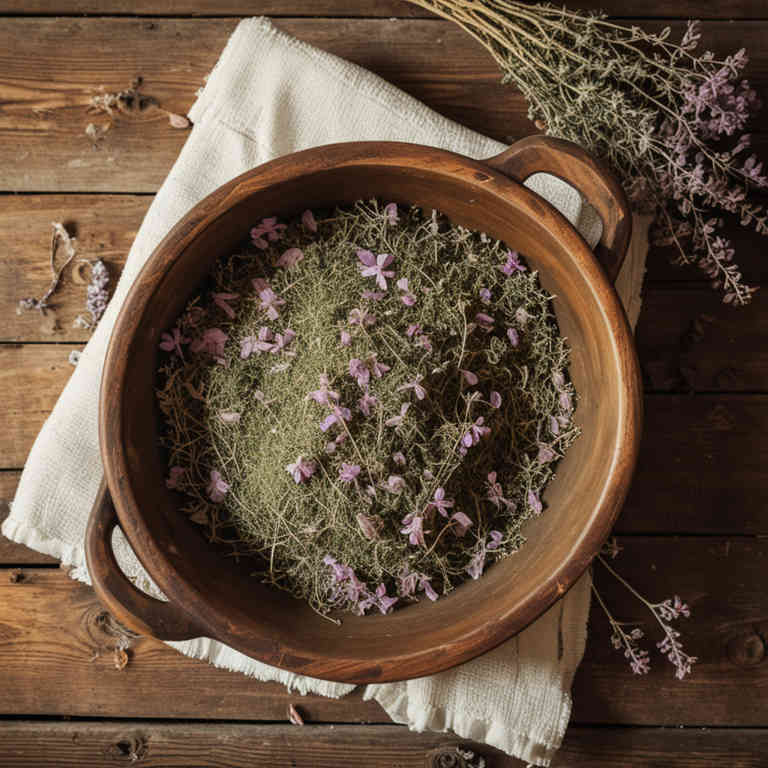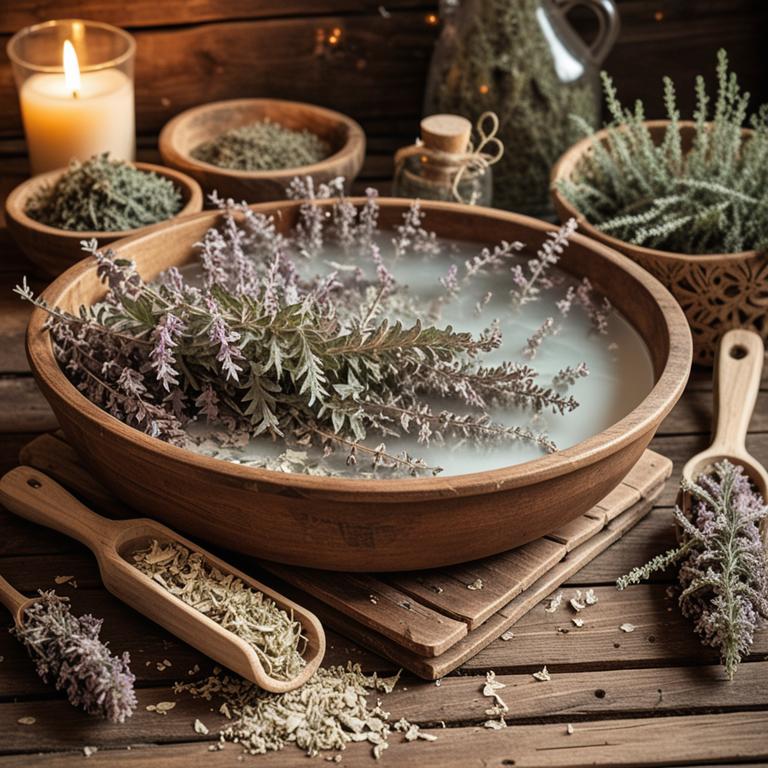10 Best Herbal Baths For Fungal Infection

Herbal baths can be an effective complementary treatment for fungal infections, as certain herbs possess antifungal and antimicrobial properties that help to reduce inflammation and combat the growth of fungi.
Commonly used herbs in these baths include tea tree oil, eucalyptus, garlic, and calendula, which are known for their natural antifungal compounds. To prepare an herbal bath, these ingredients can be steeped in hot water and then added to a warm bath, allowing the skin to absorb their beneficial properties. This method is particularly beneficial for conditions like athlete's foot or jock itch, as it provides a soothing and therapeutic effect.
While herbal baths may not replace medical treatment entirely, they can support healing and alleviate symptoms when used alongside prescribed antifungal medications.
FREE Herb Drying Checklist
How to make sure every batch retains maximum flavor, color, and aroma without the risk of mold or over-drying. Eliminate guesswork and trial-and-error, making herb drying faster, easier, and more efficient every time.
Table of Contents
1. Hypericum perforatum

Hypericum perforatum, commonly known as St. John's Wort, has been traditionally used in herbal baths to treat fungal infections due to its antifungal and anti-inflammatory properties.
When infused into bath water, the active compounds in hypericum, such as hypericin and hyperforin, can help reduce skin irritation and inhibit the growth of fungi. These baths are particularly beneficial for conditions like athlete's foot or ringworm, as they provide a soothing and cleansing effect on affected areas. The warm water helps enhance the absorption of the herb's beneficial compounds, promoting faster healing.
However, it is important to consult a healthcare professional before using St. John's Wort baths, especially if you are on medications, as it can interact with certain drugs.
2. Lavandula angustifolia

Lavandula angustifolia, commonly known as English lavender, has been traditionally used for its antifungal properties, making it a valuable ingredient in herbal baths for treating fungal infections.
The essential oils extracted from lavender contain compounds like linalool and lavandin, which exhibit antimicrobial and anti-inflammatory effects. When incorporated into a bath, these properties can help reduce the symptoms of fungal infections such as athlete's foot or ringworm by inhibiting the growth of fungi. To use lavender in a herbal bath, simply add a few drops of lavender essential oil or a handful of dried lavender flowers to warm water.
This soothing and aromatic treatment not only provides therapeutic benefits but also promotes relaxation and overall skin health.
3. Thymus vulgaris

Thymus vulgaris, commonly known as thyme, has been traditionally used in herbal baths to treat fungal infections due to its antimicrobial and antifungal properties.
The essential oils found in thyme, particularly thymol, help to inhibit the growth of fungi by disrupting their cell membranes. To prepare a thyme herbal bath, fresh or dried thyme leaves can be steeped in hot water and then added to a warm bath, allowing the skin to absorb the beneficial compounds. Regular use of thyme baths may help reduce symptoms of fungal infections such as athlete's foot or ringworm by creating an environment less favorable for fungal growth.
However, it is advisable to consult a healthcare professional before using thyme baths, especially for individuals with sensitive skin or existing medical conditions.
4. Urtica dioica

Urtica dioica, commonly known as stinging nettle, has been traditionally used in herbal baths to treat fungal infections due to its anti-inflammatory and antimicrobial properties.
When steeped in warm water, the leaves release compounds such as histamine and formic acid, which can help soothe irritated skin and reduce fungal growth. These baths are particularly beneficial for conditions like athlete’s foot or ringworm, as they provide a natural, soothing alternative to chemical treatments. The astringent properties of nettle also help to dry out fungal infections and promote healing.
Regular use of urtica dioica baths can complement other treatments and support overall skin health.
5. Equisetum arvense

Equisetum arvense, commonly known as field horsetail, has been traditionally used in herbal baths to treat fungal infections due to its high concentration of silica and antimicrobial compounds.
The plant contains silicic acid, which helps strengthen the skin's natural barrier and may inhibit the growth of fungi. When used in bath water, the active components of Equisetum arvense can be absorbed through the skin, providing a soothing and therapeutic effect. Herbal baths with horsetail are often recommended for conditions such as athlete's foot and ringworm, as they help reduce inflammation and promote healing.
However, it is important to consult with a healthcare provider before using such treatments, especially for individuals with sensitive skin or existing medical conditions.
6. Salvia officinalis

Salvia officinalis, commonly known as sage, has been traditionally used for its antifungal properties, making it a valuable ingredient in herbal baths for treating fungal infections.
When infused into water, sage leaves release essential oils such as thujone and camphor, which possess antimicrobial and antifungal effects that can help combat conditions like athlete's foot or ringworm. Soaking in a sage-infused bath can soothe irritated skin and reduce inflammation while helping to eliminate fungi from the affected area. This natural remedy is especially beneficial for those seeking alternative or complementary treatments to conventional antifungal medications.
However, it is important to consult a healthcare professional before using sage baths, especially for severe or persistent infections.
7. Teucrium polium

Teucrium polium, also known as summer savory, has been traditionally used in herbal remedies for its antifungal properties.
When used in herbal baths, it can help alleviate symptoms of fungal infections by creating an environment that is less favorable for fungal growth. The essential oils and bioactive compounds in Teucrium polium, such as flavonoids and terpenes, possess antimicrobial and anti-inflammatory effects. To prepare a herbal bath, a handful of dried Teucrium polium leaves can be steeped in hot water and then used to soak the affected area.
While it may offer complementary relief, it is advisable to consult a healthcare professional for persistent or severe fungal infections.
8. Rosmarinus officinalis

Rosmarinus officinalis, commonly known as rosemary, is a herbal remedy that has been traditionally used for its antifungal properties.
When incorporated into herbal baths, rosemary can help combat fungal infections by promoting a cleansing environment for the skin. The essential oils derived from rosemary contain compounds like camphor and rosmarinic acid, which have demonstrated antifungal effects in various studies. To use rosemary in a bath, one can add a few drops of rosemary essential oil to warm water or use a rosemary-infused bath salt.
Regular use of such baths may provide relief from symptoms of fungal infections like athlete's foot and ringworm, though it should complement, not replace, medical treatment.
9. Achillea millefolium

Achillea millefolium, commonly known as yarrow, has been traditionally used in herbal baths to help alleviate symptoms of fungal infections due to its antimicrobial and anti-inflammatory properties.
When infused into water, the essential oils and compounds in yarrow can create a soothing environment that may inhibit the growth of fungi on the skin. These baths are particularly beneficial for conditions such as athlete's foot or ringworm, as they help reduce itching, redness, and discomfort associated with the infection. To prepare the bath, a handful of dried yarrow leaves is steeped in hot water for several minutes, then strained and used to soak the affected area.
While herbal baths can provide supportive care, they should not replace professional medical treatment for severe or persistent fungal infections.
10. Cymbopogon citratus

Cymbopogon citratus, commonly known as lemongrass, is a herbal remedy that has been traditionally used for its antimicrobial and anti-inflammatory properties.
When incorporated into herbal baths, lemongrass can help soothe and treat fungal infections by creating an environment less conducive to fungal growth. The essential oils extracted from lemongrass contain compounds like citral and geraniol, which exhibit antifungal activity against various pathogens. To prepare a lemongrass bath, fresh or dried leaves can be steeped in hot water, and the infused water can be used for soaking the affected area.
While lemongrass baths may offer natural relief, they should be used in conjunction with other medical treatments for severe or persistent fungal infections.